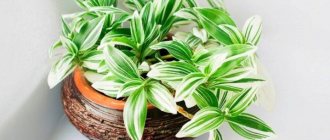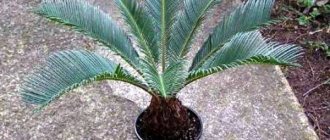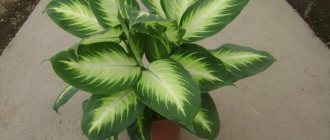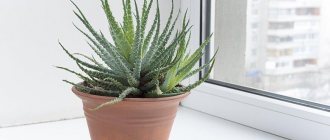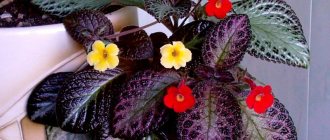This flower cannot be ignored precisely for its unusual leaves; it is bred by true connoisseurs of indoor flowers. There are many types of this plant, but it is not always possible to grow it at home due to its capricious nature and lack of necessary conditions.
Only an experienced gardener can handle its cultivation. Caring for calathea at home requires special attention.
Photo gallery
In the warm season, calathea feels comfortable at an air temperature of +20–25 °C, in winter not lower than +16–18 °C. In conditions of high humidity, the maximum permissible is +30–35 °C. The lower limit that a flower can survive is +16 °C, after which the roots will begin to rot.
The daylight hours of this plant should last 10–14 hours, so in the cold season you need to use additional lighting. If there is insufficient lighting, the flower stops growing and sheds its leaves.
Calathea needs high air humidity - at least 60%, and preferably 90–95%. Therefore, the air near the flower needs to be sprayed frequently, especially in winter. You can also increase the humidity level by placing a container of water next to the flower.
During the flowering period, you need to feed the calathea with fertilizer for flowering plants, such as Agricola, once every 14 days. Afterwards, the faded flowers should be trimmed, leaving 5 cm and removed completely when they dry out.
Benefits and harms when kept at home
There are many wishes for those who need to grow an indoor calathea flower:
- People suffering from insomnia.
- For those who often suffer from colds, the flower has warm energy (according to Chinese scientists who deal with medicinal herbs).
- People whose blood is prone to blood clots.
- With a tendency to neurosis and irritability.
It is believed that all types of calathea flowers help in trading and give self-confidence. It is recommended to grow it in houses where many people live - the plant neutralizes negative energy.
The harm from growing flowers of the arrowroot family is most likely related to their growing conditions. For example, the humidity is too high - up to 90% in the room. This can be bad for people's respiratory systems.
Where can I buy a plant?
You can buy calathea in offline and online flower shops. The cost ranges from 200 to 3 thousand rubles, depending on the type and size of the plant.
What to do immediately after buying a flower?
You need to accustom the plant to new conditions gradually; to do this, you need to place it for 2 weeks in a bright but shaded place where it is warm, there are no drafts or dampness.
After adaptation, the calathea must be replanted, completely replacing the soil and flowerpot, treated with Zircon using a spray bottle and watered generously.
Care errors
The plant is capricious and demanding of care. With proper care, Calathea will always delight your eyes.
The most common mistakes are:
- excess sunlight;
- lack of heat;
- sudden temperature change;
- excessive dry air;
- presence of drafts.
By eliminating these shortcomings, you can revive the bush and restore its decorative appeal.
What kind of pot do you need?
Calathea has a superficial root system that grows in breadth, so the pot needs to be low and wide, shaped like a bowl. Each new container should be 4–5 cm larger in diameter than the previous one.
The most suitable material is unglazed ceramics, which provides access to the required volume of oxygen to the roots.
The pot must have drainage holes, and during replanting it is necessary to lay a large layer of drainage on the bottom, which can be large pebbles, ceramic shards or expanded clay.
What kind of soil is needed?
The soil for calathea should be moisture-permeable, nutritious, have good aeration and weak (pH 5.0–6.0) or neutral (pH 6.0–7.0) acidity.
You can use ready-made soil for arrowroot or azaleas, or prepare it yourself by mixing in equal parts:
- high peat;
- leaf soil;
- humus;
- coarse sand.
To deoxidize the resulting substrate, you need to add crushed charcoal to it at the rate of 40 grams per 1 kg of soil mixture.
The soil should not contain lime.
To get rid of pests, the soil mixture must be steamed in a water bath, poured with a weak solution of manganese, calcined in the oven, or treated with insecticides and fungicides, such as Aktara, Aktellik or Fundazol.
Transfer
Due to the specific toxins released into the soil by the roots of the plant and leading to its death, replanting is a necessary procedure for calathea. It is better to carry it out in early spring.
Reasons for transplant:
- disease;
- growth of the root system;
- 14 days have passed since the purchase.
Before the calathea reaches 3 years, it needs to be replanted annually, then every 2-3 years.
Transplant instructions:
- water the plant generously 1.5 hours before transplanting;
- Place a drainage layer a quarter of the height of the container on the bottom of the flowerpot, sprinkle it with crushed charcoal or activated carbon to prevent root rotting;
- pour a layer of soil on top not exceeding 2–3 cm;
- carefully remove the calathea from the old container along with a lump of earth;
- rinse the roots in cool water;
- cut all damaged roots with a sharp knife strictly perpendicularly, remove old and dry leaves;
- treat the cut areas with crushed activated carbon or wood ash;
- place the plant in a new pot and soil, carefully straighten the roots;
- make sure that the growing point is strictly in the center of the flowerpot and above the soil surface;
- carefully pour the soil into the pot, leaving 1.5–2 cm to its upper edge;
- lightly press, but do not compact the soil.
After replanting, it is necessary to water the calathea generously and put it away for 2-3 days in a cool place where direct sunlight does not penetrate. The next watering is carried out after 8–10 days.
Reproduction methods
Dividing the bush
When transplanting calathea, which is carried out in the spring, the rhizome of an adult bush can be divided into parts if desired. It should be taken into account that each of the divisions must have several formed roots and leaf plates. Plant the cuttings in individual pots, reaching 70–90 mm in diameter, which are filled with arrowroot substrate. Place them in a shaded area and provide them with warmth and high humidity. To do this, it is recommended to place the pots on a tray filled with wet expanded clay, and a working heating device should be located not far away. Rooting cuttings takes a very long time, and the final result depends on how well you take care of them.
Propagation by cuttings
Very carefully cut off the above-ground cuttings from the mother bush. For rooting, it is planted in a moistened substrate, after which it is covered with a cut-off plastic bottle or a transparent bag. It will be possible to remove the cover only when the cuttings take root. When starting cuttings, you need to take into account that the cutting may not give roots, and this happens quite often.
Growing from seeds
It is extremely difficult to grow calathea from seeds, since even high-quality seed material may not sprout. Take a bowl and fill it with a substrate consisting of sand and leaf soil (1:2), after which the seeds are sown in it. Crops are harvested in a warm place (from 21 to 25 degrees). After the first pair of true leaf blades have formed on the emerging seedlings, they will need to be planted into a box filled with the same substrate that is used for sowing. Grown and strengthened plants are transplanted into separate pots.
Calathea - home conditions. [Hope and Peace]
Fertilizer and feeding
During the growing season (from early April to September), you need to apply fertilizers every 2 weeks, and in the fall and winter, if the plant is in satisfactory condition, reduce the number of fertilizing to once every 1.5-2 months or completely abandon them.
Suitable fertilizers are intended for plants of the Marantaceae family or universal fertilizers for decorative deciduous indoor flowers, for example, Bona Forte, Pokon, Agricola or Etisso.
Calathea reacts negatively to excess nitrogen and calcium; the content of these elements should be reduced.
Fertilizing should be done 10–15 minutes after watering; the plant should not be fertilized on dry soil.
Growing difficulties
She reacts very sharply to inappropriate conditions of detention. If she doesn't like something, Calathea leaves begin to dry, curl and fade. It reacts especially sharply to the cold emanating from window glass and open vents, so you should not keep this plant on the windowsill.
This capricious flower requires special attention. But if you follow all the rules for caring for Calathea, then it will delight you with its unusual beauty for a long time.
Watering
On average, it is necessary to water calathea 2-3 times a week in summer, and once every 7-8 days in winter, but it is better to focus on the condition of the top layer of soil - it should dry out 2-4 cm.
The water from the pan must be drained after 20–25 minutes. Stagnation of moisture should not be allowed, as it leads to rotting of the roots.
It is necessary to avoid getting water on the leaves of the calathea, so for watering it is better to use a watering can with a narrow spout, and for spraying - a spray bottle that sprays small drops. Water getting on the leaves leads to the appearance of dark spots on them.
Water for irrigation and spraying should be soft, ideally rain or melt, and have a temperature not lower than +25–26 °C.
Calathea varieties with velvety leaves cannot be sprayed.
If you are going on vacation
You can leave the calathea unattended for no longer than 3–5 days; over a longer period it may die.
The plant cannot be watered in advance or the watering process cannot be controlled; this will lead to rotting of the roots, and without moisture the calathea will dry out.
Popular decorative varieties
The genus Calathea consists of more than two hundred species. All of them are found in the wild and differ in shape, color and pattern on the leaves. Of these, there are a small proportion of “domesticated” varieties that tolerate indoor climate, but among them there is an undeniable variety for those who want to decorate their home flower garden.
Here are descriptions of some of them (with names and photographs).
Bachema
The leaves of this species are narrow, dense and long, with a pointed, elongated shape. Their length reaches 35-40 cm. There are no stems, and the leaves are held only on fairly high cuttings, forming a dense rosette. The variety is memorable for its silvery coloring on the front surface of the leaves, alternating with a dark green color along the central and lateral veins. The result is a colorful, interesting twig-shaped pattern.
Calathea Bachema feels good in an apartment, being the least demanding variety.
Varshevich
The leaves are large, oval-shaped, velvety to the touch. The front side is rich green with a light green pattern along the veins. The back side contrasts with a purple color.
Pests. Table
| Name | How to detect? | How to save? |
| Spider mite | A thin, barely noticeable white web appears on the bottom of the leaves. The leaves begin to curl, turn yellow and dry out. | wipe the leaves with a warm soapy solution, spray the plant with acaricides (Apolo, Borneo, Envidor), systemic (Biotlin, Calypso) or enteric-contact insecticides (Fitoverm, Actellik). |
| False scale insects | Pests feed on the sap of the plant and secrete a lot of sticky excrement, which is why the leaves become sticky, begin to shine, and become covered with a gray or black coating. Young leaves dry out and old leaves turn yellow. | •Wipe the calathea with cotton wool soaked in 70% alcohol or soap suds, repeat the procedure 4 times every 5–7 days; • spray with an insecticide, for example “Aktara”, “Aktellik” or “Intavir”. |
| Mealybug | Cotton-like pellets appear on the stems, in the axils of the leaves, near the root collar, and plant growth slows down. | Wash the plant with soapy water, diluting 20 grams of soap in 1 liter of water. In case of severe infection, treatment with Mosplan, Decis or Fitoverm insecticides is required. |
| Whitefly | A shiny, sticky coating appears on the leaves; when you shake the plant, you can see insects flying out of it. | Treat twice with an interval of 10 days with Verticillin or Pegasus or once with Confidor, Mospilan or Fufanon. |
Problems with leaves. Table
| Symptoms | Causes |
| The tips of the leaves dry out and wither | Insufficiently humid air in the room. |
| Yellow or brown, but do not dry out. | Excess fertilizing or cold air, draft. |
| Leaves fall. | •low air humidity; •excessive watering; •acid soil. |
| The leaves dry out and curl. | If this is accompanied by a slowdown in growth, it means that the calathea does not have enough moisture or fertilizing. |
| Light spots on the leaves. | Sunburn caused by direct sunlight. |
| The leaves become long, thin and light. | Calathea lacks light. |
Diseases
With proper home care, the flower is resistant to diseases, but excessive watering can lead to root rot. In this case, it is necessary to urgently replant the plant with a complete replacement of the soil and flowerpot, removing all damaged parts of the flower.
Errors when leaving
As a result of improper care, calathea loses its decorative appearance, it is affected by diseases and pests, and the plant dies. Thus, the wrong choice of soil and an inappropriate level of humidity in the room cause problems with the leaves of the flower, which lose their decorative effect, dry out and fall off, and excessive watering leads to rotting of the roots.
Features of Calathea
Calathea differs from many other plants in its spectacular foliage, but it also has other characteristic features. Most calathea species have underground stems that form a surface root system, from which rosettes grow, consisting of large oval-shaped leaf plates, their length varies from 0.3 to 0.4 m. The leaves have long petioles. The height of the bush can vary from 0.7 to 0.9 m. During flowering, flowers are formed on the plant that do not represent any decorative value. However, Calathea Warszewicz and Calathea saffron bloom quite spectacularly, their unsightly flowers hidden behind showy bracts that can be colored white, pink, cream or orange.
When grown indoors, calathea is highly demanding in terms of conditions and care. But there are types and varieties that are less demanding than others. Thus, it is easiest to grow species indoors such as: calathea Bachema, decorated, Makoya, striped, Veicha (Vicha), etc.
Like other representatives of the Marantaceae family, Calathea has one peculiarity - in the evening its foliage folds and rises upward, like the palms of a praying person. In the morning, the leaf blades lower and straighten again. Calathea, like its related arrowroot, is also called the “prayer flower.”
Calathea
